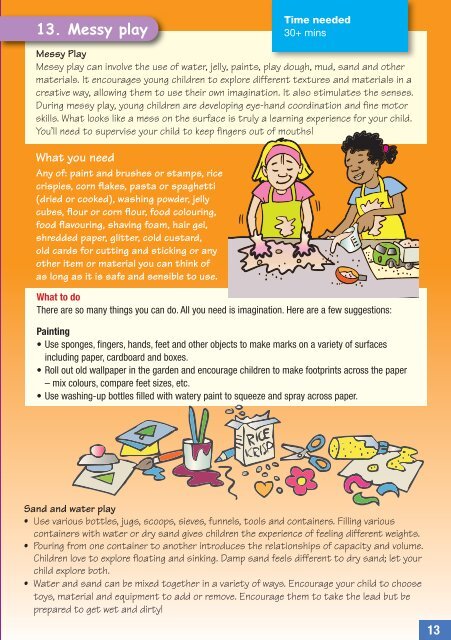Daddy, Lets play HR copy
Create successful ePaper yourself
Turn your PDF publications into a flip-book with our unique Google optimized e-Paper software.
13. Messy <strong>play</strong><br />
Time needed<br />
30+ mins<br />
Messy Play<br />
Messy <strong>play</strong> can involve the use of water, jelly, paints, <strong>play</strong> dough, mud, sand and other<br />
materials. It encourages young children to explore different textures and materials in a<br />
creative way, allowing them to use their own imagination. It also stimulates the senses.<br />
During messy <strong>play</strong>, young children are developing eye-hand coordination and fi ne motor<br />
skills. What looks like a mess on the surface is truly a learning experience for your child.<br />
You’ll need to supervise your child to keep fi ngers out of mouths!<br />
What you need<br />
Any of: paint and brushes or stamps, rice<br />
crispies, corn flakes, pasta or spaghetti<br />
(dried or cooked), washing powder, jelly<br />
cubes, flour or corn flour, food colouring,<br />
food flavouring, shaving foam, hair gel,<br />
shredded paper, glitter, cold custard,<br />
old cards for cutting and sticking or any<br />
other item or material you can think of<br />
as long as it is safe and sensible to use.<br />
What to do<br />
There are so many things you can do. All you need is imagination. Here are a few suggestions:<br />
Painting<br />
• Use sponges, fi ngers, hands, feet and other objects to make marks on a variety of surfaces<br />
including paper, cardboard and boxes.<br />
• Roll out old wallpaper in the garden and encourage children to make footprints across the paper<br />
– mix colours, compare feet sizes, etc.<br />
• Use washing-up bottles fi lled with watery paint to squeeze and spray across paper.<br />
Sand and water <strong>play</strong><br />
• Use various bottles, jugs, scoops, sieves, funnels, tools and containers. Filling various<br />
containers with water or dry sand gives children the experience of feeling different weights.<br />
• Pouring from one container to another introduces the relationships of capacity and volume.<br />
Children love to explore fl oating and sinking. Damp sand feels different to dry sand; let your<br />
child explore both.<br />
• Water and sand can be mixed together in a variety of ways. Encourage your child to choose<br />
toys, material and equipment to add or remove. Encourage them to take the lead but be<br />
prepared to get wet and dirty!<br />
13


